
Understanding Artificial Intelligence
Last Updated on July 21, 2020 by Editorial Team
Author(s): Lawrence Alaso Krukrubo
A few minutes exploring AI…
Artificial Intelligence (AI) is such a buzz word these days and one thing about buzz words is… ‘They often get lost in translation’.

Ask any Data Scientist (including yours truly) about AI, and you’re likely to hear Machine Learning (ML) algorithms or Deep learning (DL) and its fantastic applications, such as in AlphaGo… Where the Neural network learned through reinforcement learning, defeated the Go world champion, making AlphaGo arguably the strongest Go player in history… These are all applicable responses.
But I think it’s time we all take a deep breath, exhale, pause… And realize that AI is a well-founded discipline in its own right.
Machine Learning and Deep Learning do not define Artificial Intelligence. Make no mistakes. AI is a much broader field than ML, which is a Statistical subset of AI and DL, which is a specialized subset of ML involving Neural networks computation…
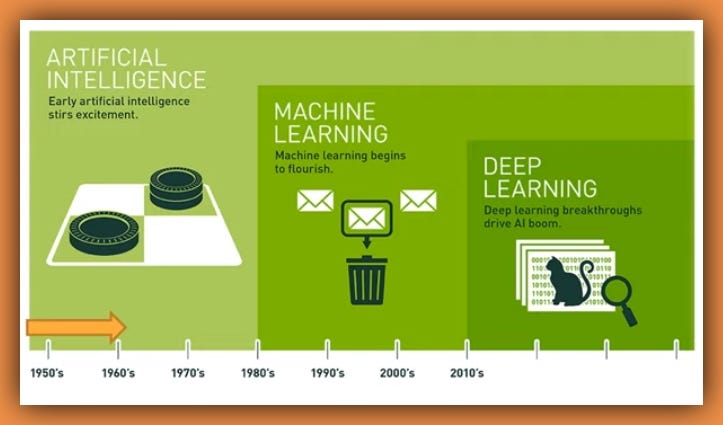
So what exactly is Artificial Intelligence?
To answer this question we must consider the four historical approaches to AI.
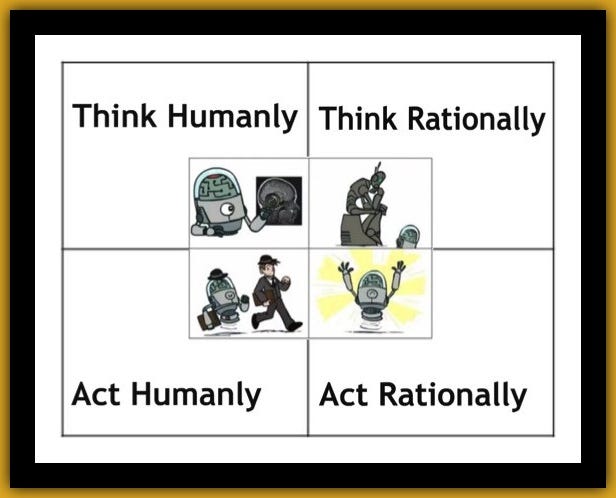
The two groups at the top are concerned with thought processes and reasoning. while those below address behavior.
Let’s look at these closer…
1. Think Humanly:
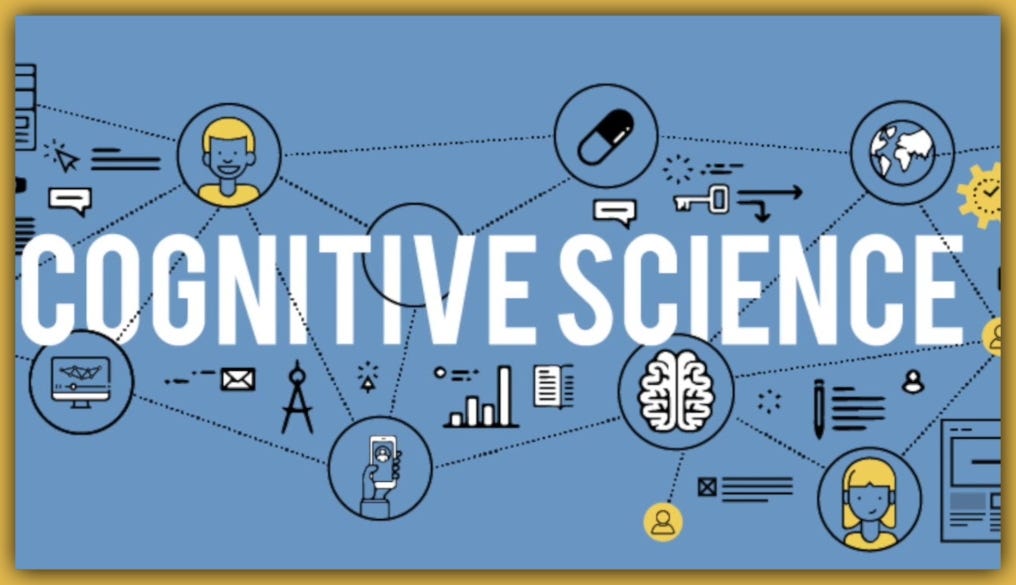
Def One:
AI is the exciting new effort to make computers think… Machines with minds, in the full literal sense… (Haugeland, 1985)
Def Two:
AI is the automation of activities that we associate with human thinking, activities such as decision-making, problem-solving, learning…(Bellman, 1978)
Think-Humanly is the Cognitive-Modelling-Approach. It basically says if we’re going to design an algorithm that thinks like a human, then we must have some way to determine how humans think.
There are 3 ways of doing this:-
1. Through Introspection: Trying to catch our own thoughts as they go by.
2. Through Psychological Experiments: Observing a person in action.
3. Through Brain Imaging: Observing the brain in action... (EEG built by Hans Berger)
The interdisciplinary field of cognitive science brings together computer models from AI and experimental techniques from psychology to construct precise and testable theories of the mind.
There have been notable strides in the use of cognitive-modeling-approach, one that comes to mind is Control labs. These guys have partnered with Facebook, and are building a non-invasive neural-interface-technology called intention-capture, that can help you control objects with only your brain signals.
2. Think Rationally:

Def Three:
AI is the study of mental faculties through the use of computational models… (Charniak and McDermott, 1985)
Def Four:
AI is the study of computations that make it possible to perceive, reason and act… (Winston, 1992)
Think-Rationally is the Laws-of-Thought-Approach to AI. The Greek philosopher Aristotle, was one of the first to attempt to codify “right-thinking”. He used syllogisms that provided patterns for argument structures. For example:-
Socrates is a man; All men are mortal => Therefore, Socrates is mortal.
These laws of thought were supposed to govern the operations of the mind, their study initiated the field called Logic. The so-called Logicist tradition within AI tries to build computer programs that can solve any solvable problem described in logical notation. This approach was popular during the late ’60s and ’70s.
3. Act Humanly:
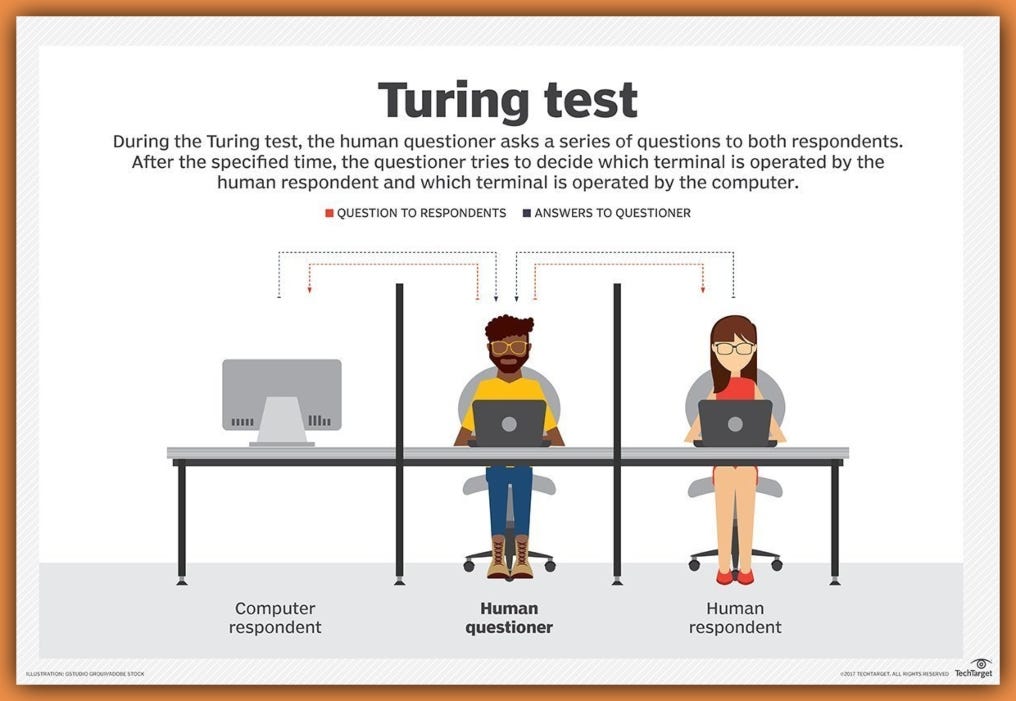
Def Five:
AI is the art of creating machines that perform functions that require intelligence when performed by people… (Kurzweil, 1990)
Def Six:
AI is the study of how to make computers do things at which, at the moment, people are better… (Rich and Knight, 1991)
Act-Humanly is the Turing Test Approach. The Turing Test, proposed by Alan Turing (1950), was designed to provide a satisfactory operational definition of Artificial Intelligence. A computer passes the Turing Test if a human interrogator after posing some written questions, cannot tell whether the written responses come from a person or from a computer. A computer would need to possess the following minimum capabilities to pass this test:
A. Natural Language Processing: To enable it to communicate successfully
B. Knowledge Representation: To store what it knows or hears
C. Automated Reasoning: To use stored data to answer questions and draw new conclusions.
D. Machine Learning: To adapt to new circumstances, detect and extrapolate patterns.
I’d leave you with more insights about Turing Test from Lex Fridman here.
4. Act Rationally:

The 1997 chess match between Garry Kasparov and IBM DeepBlue was the first defeat of a reigning World Chess Champion by a computer under tournament conditions.
Def Seven:
Computational Intelligence is the study of the design of intelligent agents… (Poole et al, 1998)
Def Eight:
Artificial Intelligence is concerned with intelligent behaviour in artefacts… (Nilson, 1998)
Act-Rationally is the Rational-Agent-Approach. A rational agent is one that acts so as to achieve the best outcome, or when there’s uncertainty, the best expected outcome. The Rational-Agent-Approach has two advantages over the other approaches:-
First, a Rational-Agent is more general than the rest. Take for example the Laws-of-thoughts approach that places emphasis on making correct inferences. Well, making correct inferences is often part of a Rational-Agent. Besides, there are other ways of acting rationally without inference, for example, recoiling from a hot stove is a rational reflex action devoid of inferences.
Secondly, Rational-Agent-Approach is more amenable to scientific developments than are approaches based on human behavior or human thought.

Intelligence is relative… An agent’s domain affects how we judge its level of intelligence…
Take Siri for example, she can recommend nice, safe places we ask her, and even communicate these answers to us in a human voice capacity, but no matter how we try, Siri cannot take our car wheels and drive us to that fancy restaurant.
She’s intelligent only in the domain of having a conversation…
Defining Intelligence:
There are certain qualities of both artificial and biological systems that we ascribe to the notion of intelligence.
For AI to be productive, our notion of intelligence should not be contingent on how we perceive something, rather intelligence should be defined within the context of a task.
It just turns out that humans are intelligent in doing several different things.

We’ve seen eight distinct, definitions of Artificial Intelligence. It’s crucial to note that all four approaches of AI are centred around the ‘Human ideology’.
Think Humanly…
Think Rationally…
Act Humanly…
Act Rationally…
What does the adverb ‘Humanly’ really mean?…
Let’s see Oxford’s definition:
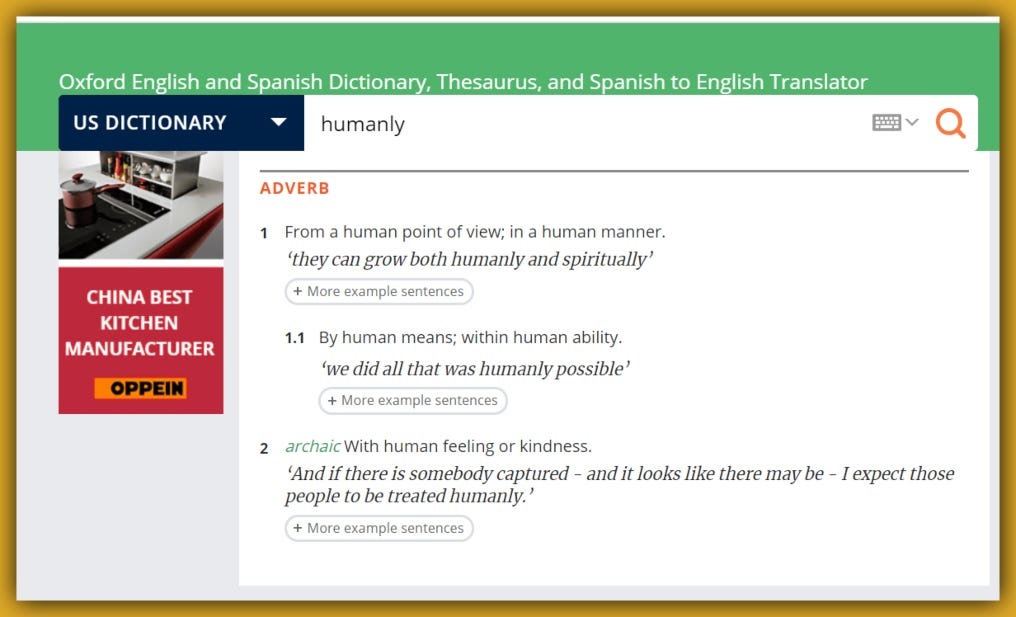
Let’s see Merriam Webster’s definition:
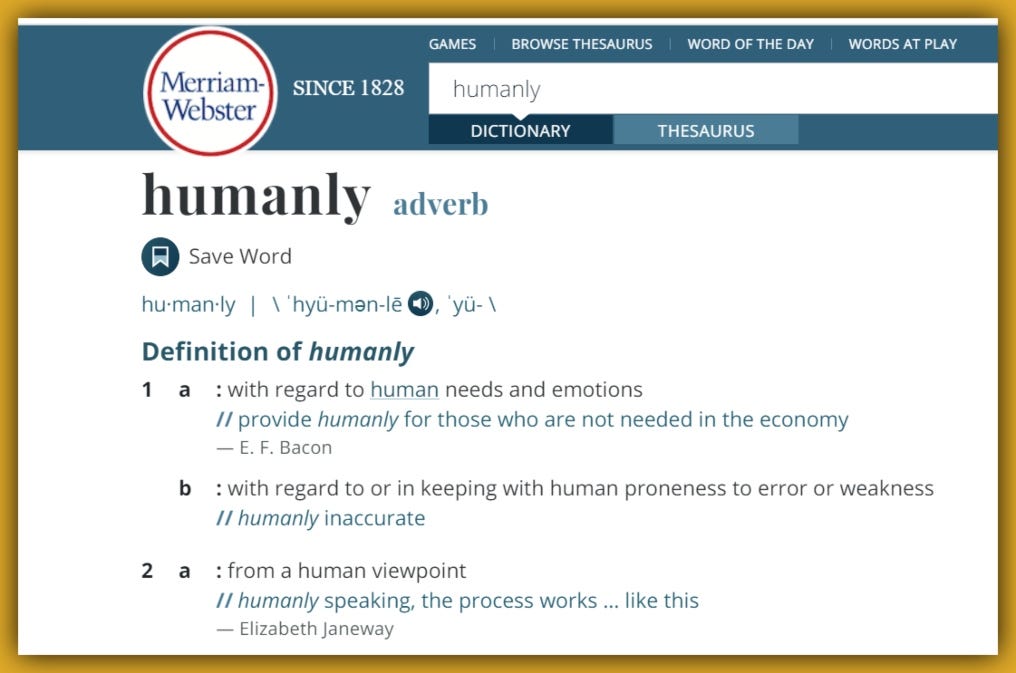
We all need to get off our high-horses, sit ourselves down and recognize the Truth about AI…
Artificial Intelligence is a tried and true science, that seeks to advance humanity, by creating rational and intelligent machines that tend to human needs and emotions and cater to human feelings and kindness… Machines for the good of All people, without bias.
And this here is my own definition of Artificial Intelligence!
Foundations and Scope of AI
Foundations:
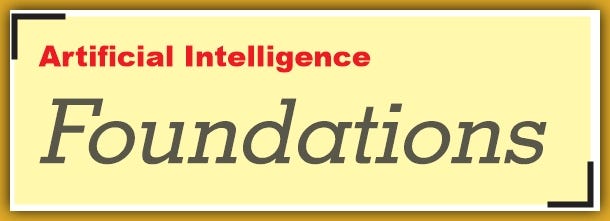
Different people approach AI with different goals in mind. Two important questions to ask while building AI applications are:-
- Are you concerned with thinking or Behaviour?
- Do you want to model humans or work from an ideal standard?
Let’s see the components of AI as an interdisciplinary subject…
- Philosophy: Going back 400 B.C, Philosophers made AI conceivable by considering the ideas that the mind is in some ways like a machine. That knowledge is encoded in some internal language.
- Mathematics: Mathematicians provided the tools to manipulate statements of logical certainty as well as uncertain probabilistic statements.
- Economics: Economists formalized the problem of making decisions that maximize the expected outcome to the decision-maker.
- Neuroscience: Neuroscientists discovered some facts about how the brain works and the ways in which it is similar to and different from computers.
- Psychology: Psychologists adopted the idea that humans and animals can be considered as information processing machines.
- Linguistics: Linguists showed that language use, fits into this computational model.
- Computer Engineering: Computer Engineers provide ever-more-powerful machines that make AI applications possible. Such as the latest A2 virtual machine at GCP, Based on the NVIDIA A100 GPU.
- Control Theory: Control Theorists deal with designing machines that act optimally on the basis of feedback from the environment
Others include Statisticians and Physicians and disciplines that provide domain knowledge to computational processes or theories that support AI.
Scope:
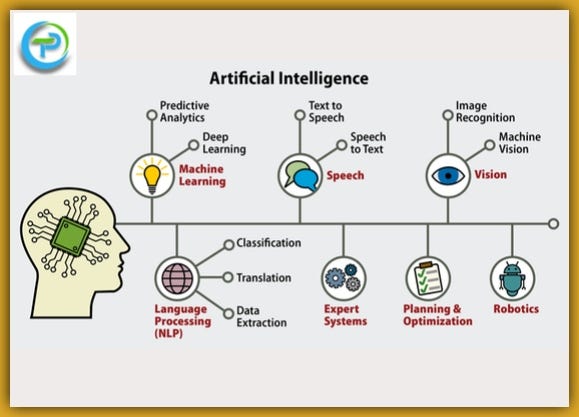
The diagram above highlights some of the core units of AI, Note that this list is by no means conclusive:-
- Machine Learning
- Deep Learning
- Speech: text-to-speech and speech-to-text
- Vision: image-recognition and machine-vision
- Language Processing: translation, classification, extraction
- Robotics
- Search: A-star, DFS, BFS, UCS, e.t.c…
- Planning and Optimisation
- Decision Intelligence
- Statistical Learning
The last two are quite interesting and relatively new disciplines.
Statistical Learning (SL): Was created as a result of the advancements in Machine Learning. SL is a subset of Statistics that focuses on unsupervised and supervised modeling and predictions. SL goes a Lil deeper than ML in that, it aims to explore the parameters and configurations behind the implementations of algorithms.
Decision Intelligence: Is an engineering discipline that augments data science with theory from social science, decision theory, and managerial science. We can see more of this on Wikipedia.
Or, let Cassie Kozyrkov, The Head of Decision Intelligence at Google tell us exactly what Decision Intelligence means.
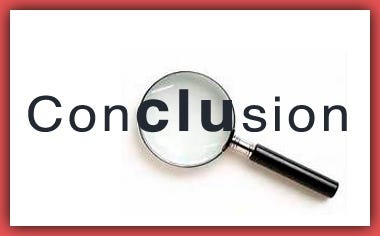
Summary:
It’s been the dream of the founding fathers of Artificial Intelligence to create machines that can simulate human thought processes and behavior, without bias.
Humans were all born Pure… Innocent and True. We let societal influences, environmental, racial, and cultural factors negatively affect our volition to the Good. This may be the cause of some bias in AI implementation today.
AI was never meant to create divide and hate. People let their negativity rub off on the technology. As a people, if we want a future that actualizes the promises of Artificial Intelligence for the overall good of mankind…
Then we must support inclusiveness in AI, we should utilize fairness libraries like aif360, we should make our data explorations to be model and predictively explainable. We should use explainability libraries like aix360, LIME as well as libraries like LALE to foster automation and reduce human errors.
But above all, we must think humanly, think rationally, act humanly and act rationally at all times.
Finally,
This article cites AI exploration from AIMA, 3rd Edition, chapter 1. AIMA is the most influential text ever written on Artificial Intelligence. By Peter Norvig and Stuart Russell, with contributions from a few, including Sebastian Thrun.
Here’s a word-cloud shout out to some of the Veterans and Heroes in AI
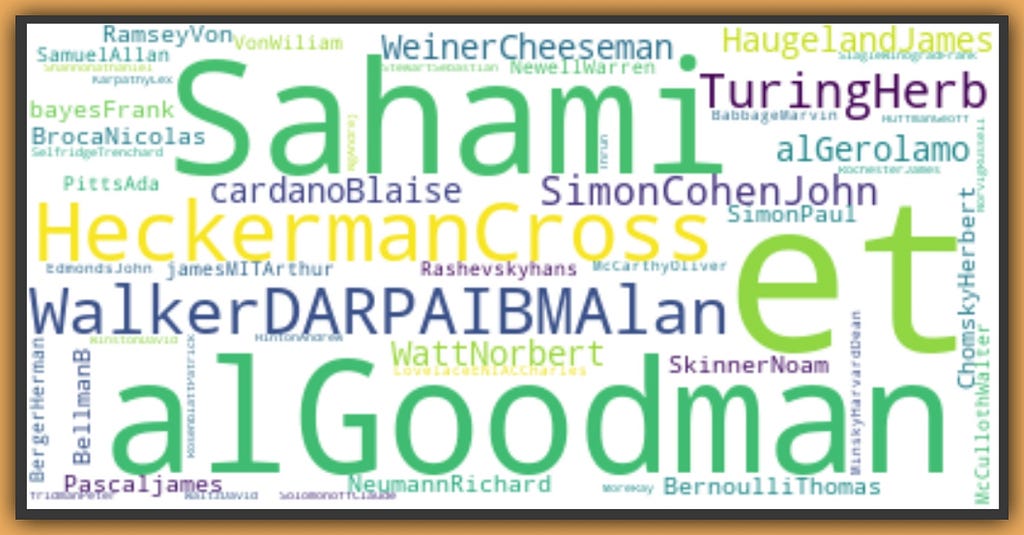
Thanks for reading this… When next you hear the words Artificial Intelligence, look beyond the glitz and the glam, look beyond the amazing applications of AI… Put your sights on humanity… Let Fairness and Explainability guide your projects.
Cheers!
About Me:
Lawrence is a Data Specialist at Tech Layer, passionate about fair and explainable AI and Data Science. I hold both the Data Science Professional and Advanced Data Science Professional certifications from IBM. After earning the IBM Data Science Explainability badge, my mission is to promote Fairness and Explainability in AI… I love to code up my functions from scratch as much as possible. I love to learn and experiment…And I have a bunch of Data and AI certifications and I’ve written several highly recommended articles.
Feel free to connect with me on:-
Understanding Artificial Intelligence was originally published in Towards AI — Multidisciplinary Science Journal on Medium, where people are continuing the conversation by highlighting and responding to this story.
Published via Towards AI
Take our 90+ lesson From Beginner to Advanced LLM Developer Certification: From choosing a project to deploying a working product this is the most comprehensive and practical LLM course out there!
Towards AI has published Building LLMs for Production—our 470+ page guide to mastering LLMs with practical projects and expert insights!

Discover Your Dream AI Career at Towards AI Jobs
Towards AI has built a jobs board tailored specifically to Machine Learning and Data Science Jobs and Skills. Our software searches for live AI jobs each hour, labels and categorises them and makes them easily searchable. Explore over 40,000 live jobs today with Towards AI Jobs!
Note: Content contains the views of the contributing authors and not Towards AI.












